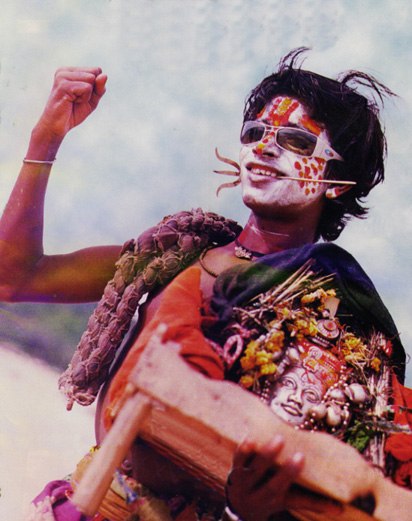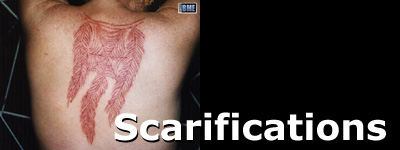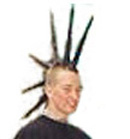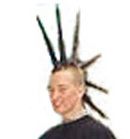Ever notice that an awful lot of kids today are getting into piercings and tattoos? Ever wonder why that is? On the surface it's just today's fashion, and the preponderance of kids do it because they like the look. But there is also a serious cultural movement behind it that is steeped in historical tradition. The movement is called the Urban Primitive or Modern Primitive Movement, and is strongly aligned with Tribalism. They are symbolic rejections of the modern technological age. I say symbolic, because these people do not litterally reject modern technology as the Amish people do. It is more a statement that more we depend on technology, the further we remove ourselves from the fundamentals of humanity. The "Modern Primitive" movement seeks a return to primitive times, still within the context of our modern, technological civilization. If you look through a National Geographic magazine and see pictures of "primitive" tribes, you'll see them with radical piercings, tattoos, scarifications, and many other alterations of their natural appearances. These kinds of body modifications are older than civilization itself. Deliberately modifying the body is the one trait that the human race shares that sets it apart from the animals. Virtually all primitive societies adopted these practices independently. It appears to be something deeply rooted in the human nature. By embracing radical, visually striking body modifications, contemporary people are drawing a symbolic tie back to primitive times without rejecting modern technology.  | This lad is thoroughly modern in every way, yet he adorns himself with the trappings of a primitive society, even going so far as to poke a spike through his own cheek to mimic the practices of primitive tribes |
Tribalism is also a restructuring of our social groups. In the last quarter of the 20th century the family unit started breaking down. The unfortunate fact that ultra conservatives use this as a misguided attack against the gay community doesn't make it any less true. Intact families are becoming fewer and fewer. Because of this, alternative social structures have been coming into existance. Tribalism is one of them. In "primitive" times, body modifications originally were adopted as a means of distinguising members of one tribe from another. Most of these people ran around naked, so distinctive clothing wasn't an option. Instead they took on distinctive hair styles, body paints, and eventually piercings and other body modifications as a means of visually distinguising members of their tribe from others. This also helped to cement their sense of community. Not only did they share food and territory, they shared a common and distinct appearance. Today, body modifications still serve to create a sense of community. It may be on a more subconscious level, but it still works. When one guy with lots of tattoos and facial piercings sees another guy with lots of tattoos and facial piercings, they each know instantly that they have something in common. They're each a member of the "tribe." By comapring their body modifications and sharing war stories of having them done, total strangers have something to talk about right off the bat. Each also knows that the other is the kind of person who will do as he wishes despite the condescending disdain of "normal" people. Radical body modifications also deonte a greater sense of commitment to one's community. It's a lot easier to put on an aligator shirt or club tie than it is to undergo deep-flesh piercings. Beyond that, people in the "tribe" could be stripped naked and still bare the symbols of their community.
Body Modifications
"I like pleasure spiked with pain" | Red Hot Chili Peppers
|  Tattoos were originally invented in Polynesian islands. These were often elaborate, full-body tattoos. Some even had tattooed faces. Japan also had a tradition of full-body tattoos. Tattoos became popular in the 20th century, mostly among sailors, bikers, and other rebels. These were usually located on the arms, or maybe the chest. With the advent of the Modern Primitive movement, there has been a return to more elaborate, full-body tattoos. Whereas some enthuiasts would continue getting more and more individual tattoos until practically their whole bodies were covered, modern sensibilities tend toward more unified designs that are intended from the onset to cover the body. Modern techniques also allow more intricate, colorful designs, but many opt for bold, simple designs in flat black.
 Women have had pierced ears for a long time. Sailors also had a tradition of having a pierced ear. It wasn't unusual. But that was about as far as piercing went. In the post-hippie generation, piercings began to become more elaborate. More men in mainstream society were getting a pierced ear. For a while it was a way of subtly displaying one's homosexuality ("Left is right and right is wrong," the breeders would say). Before long kids were getting both ears pierced. I remember a school teacher once commenting how shocked he was when he started seeing tough guys walking around wearing earrings. Soon people were getting multiple peircings in each ear. Then it expanded to noses, eyebrows, lips, and even stright through the tongue. Where Grateful Dead concerts were populated by kids with bushy hair and scraggly beards, Phish concerts became populated by kids with shaved heads and multiple facial piercings. That was only the beginning. Piercings in places below the neck also became popular. Nipples and belly-buttons were favorite spots. Ultimately piercings even moved below the waist. Females have limited options for piercing their genitals, but males have all sorts of places to stick things. There are no fewer than a dozen classifications of male genital piercints. From the "traditional" Prince Albert, which inserts a hoop into the urethra to emerge through the skin on the under side of the penile shaft, to the guiche piercing behind the scrotum where it meets the perineum, it seems there is no limit to the ways in which a men can skewer their genitals. Piercings are the least permanent of all body modifications. Jewelry can be removed with nothing more than a small spot of scar tissue to reveal that it had ever been there to begin with. It also requires a shorter duration of pain to implement, but no less bravery. Somthing about a sharp object being thurst through the epidermis is fundamentally contrary to our evolutionary programming.
 Branding has long been popular as a fraternity initiation ritual. By the time I pledged a fraternity, such activity was clearly defined as illegal hazing. But oddly, after pledges were initiated as members, they frequently opted to voluntarily undergo the process. In recent times, branding has become more common in "main stream" society (within the confines of the Modern Primitive subculture). Branding has traditionally been something that is done to cattle. By doing it to ourselves, we get in touch with our animal nature. Or, more accurately, we take ownership of our animal nature. This is not something that a dominant species inflicts on a submissive species. It's something that we do to ourselves deliberately and voluntarily. Similar to piercings, branding goes against our evolutionary programming. Subjecting our skin to searing heat, leaving scar tissue behind, should be anathema. But by embracing the injury and the subsequent wound, we triumph over the fire that our primal nature has taught us to fear.
 Scarifications are among the earliest body modifications employed by primitive peoples. Early man obviously noticed that cuts to the skin would leave lasting scars. By making deliberate cuts, they could create lasting designs. Like branding, it's found its place in the modern spectrum of body modifications.
Counter Culture index | Next Essay: Gay Skinheads
| 


